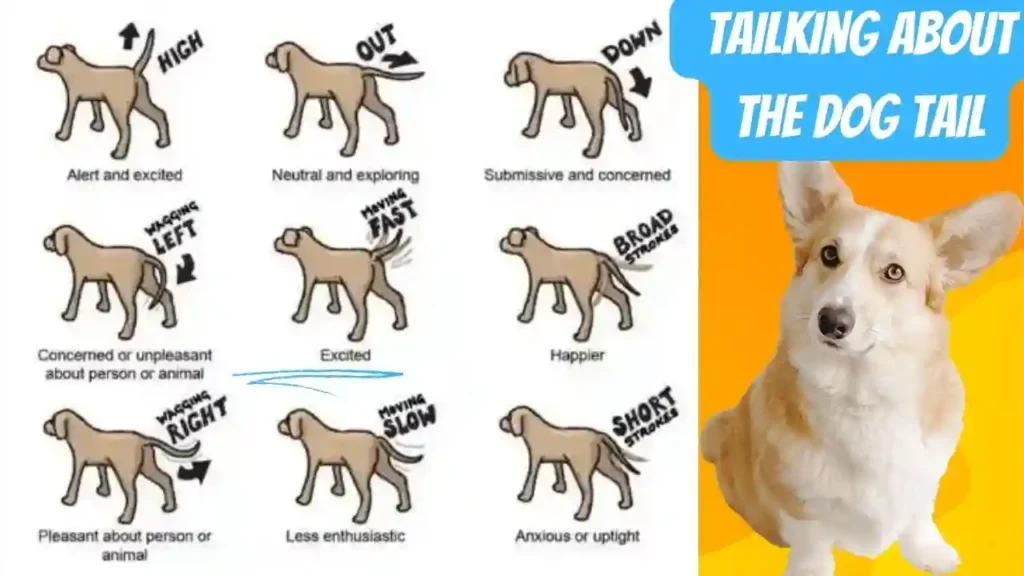Learning to understand your dog’s body language is crucial for pet owners. It helps you connect with your dog on a deeper level and ensure their emotional well-being.
The Language Of Dog’s Ears: Dog Body Language
People say a dog’s ears can tell you a lot about how they feel, and knowing how they move and place them is essential. People with perked ears usually seem interested, aware, or alert. Pinned ears show fear, submission, or nervousness. When ears are relaxed, it generally means that someone is happy. If you have flopped ears, it could mean that you are calm and easygoing.

Talking about the Dog tail: A dog’s tail can tell you how it feels. A tail wag usually means a dog is happy or excited, but not all wags are alike. Dogs often wag their tails quickly and high when they are glad, while low, slow wags can mean they are not sure what to do or are giving up. On the other hand, a stiff, high tail may mean violence or control, while a tucked tail means fear or worry.
Dog Facial Expressions: Dog Body Language
The look on a dog’s face can tell you a lot. A dog that looks soft and relaxed is probably happy and calm. But blinking or turning your eyes away can be a sign of stress. Wide eyes can show fear or joy. Usually, a straight, hard stare means that someone is angry or wants to be in charge.
If a dog shows its teeth, it could mean it is angry, but it’s essential to tell the difference between a submissive grin, which usually comes with a moving tail, and a mean snarl. Having wrinkles on your forehead or tense facial muscles can indicate pain or stress.
Dog Posture And Movement: Dog Body Language
How a dog stands or lies down can show how it feels. A tall dog with a calm stance feels good about itself and is confident. But shrinking or slinking, on the other hand, means giving up or being afraid. A stiff, straight stance could mean that someone is angry.
When the front end of a bow is dropped while the back end stays up, it’s called a toy bow. Dogs deal with stress by shaking off as if wet or stretching. Scared or nervous dogs tend to move slowly and deliberately, while excited dogs tend to move quickly and bouncy.
Vocalizations and Other Sounds
Dogs use many different sounds to talk to each other. Barking can show many feelings, from being alert to being scared or angry. Animals can use growls to warn others or show they’re having fun. Whine and whimper sounds often indicate pain or a need for attention. Howling can signify being alone or reacting to sirens or other loud noises. Pay close attention to the pitch and length of a dog’s sounds; they can tell you a lot about how it’s feeling. Some sounds, like yips and yelps, can mean pain or joy.
The Importance Of Context
When it comes to dog body language, context is critical. It is essential to recognize the main parts of body language, facial emotions, stances, and sounds made by animals. Still, it is also necessary to understand what these signs mean in the bigger picture.
A moving tail could mean happiness and energy, but it needs to be interpreted differently when it’s near a dog trying to scare the person. An alarm growl is very different from a play snarl. To understand what your dog is trying to say, you should always look at the bigger picture, including the dog’s past, surroundings, and the unique situation where these cues appear. Context is critical for correct perception.
The Role Of Dog Training And Socialization
A dog’s body language is determined by how well it is trained and socialized. With the proper training, you can instruct your puppy on rules and cues to make talking to him more accessible. If you train your dog well, it’s more likely to show that it’s calm and at ease. Socialization is also crucial, especially in the early stages, when it’s most important.
Exposure to different people, animals, and places early on can lessen the effects of anxiety and fear. It makes dogs more flexible and better able to understand what’s going on around them. Both training and education are essential for training a dog to behave better and building a solid base for clear and peaceful body language communication.
Common Misconceptions and Mistakes
● Mistaking a Wagging Tail for Friendship: A dog’s tail can wag when happy, but it doesn’t always mean the dog is friendly.
● Misinterpreting a Growl: A growl used for play differs from a growl used to warn or attack.
● Assuming All Dogs Like Hugs: Many dogs don’t like being hugged or think they are dangerous.
● Ignoring Other Body Language Cues: If you only look at the dog’s tail, you might not understand how it feels.
● Misinterpreting Submissive Behavior: Clutching your tail or cowering can be signs of fear, not submission.
● Ignoring Signs of Fear: If a dog shows nervousness, you shouldn’t put it in new or stressful settings.
● Thoughts That All Dogs Are The Same: Every dog is different, and their body language can be foreign too.
Building A Stronger Bond With Your Dog
Knowing your dog’s body language isn’t just a way to talk to them; it’s also a way to build a stronger bond with them. You show that you care and understand them when you can read their body language and react correctly. This helps build trust and strengthens the mental bond between you and your dog.
Body language understanding allows people to communicate clearly, which leads to a happy connection. It lets you meet their wants, feel safe, and give them peace. In turn, your dog feels like you understand and value him. When two people share a language, they can bond more deeply, which leads to a better, healthier, and more caring connection.
Conclusion
Understanding your dog’s body language is an essential skill for pet parents to have. You can bond with your dog more deeply and ensure they are emotionally healthy. You can meet your dog’s needs by reading his ears, tail, facial emotions, posture and movement, and vocalizations, as well as considering the situation.
Training, socializing, and avoiding common misunderstandings are essential for communicating well with your animal friend. Your relationship with your dog will be happy and healthy if you can read his body language well and build a stronger bond with him.







Leave a Comment
You must be logged in to post a comment.